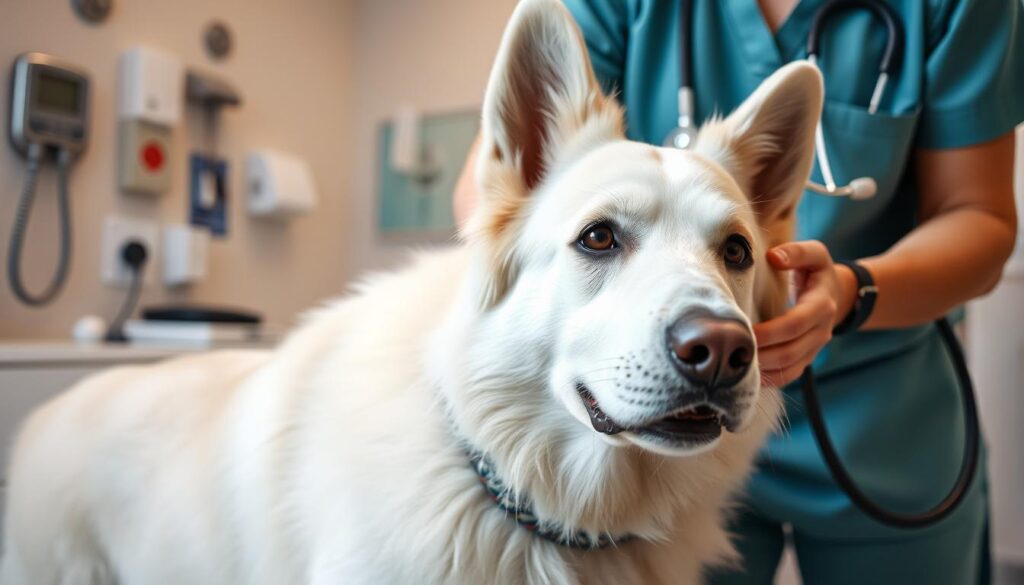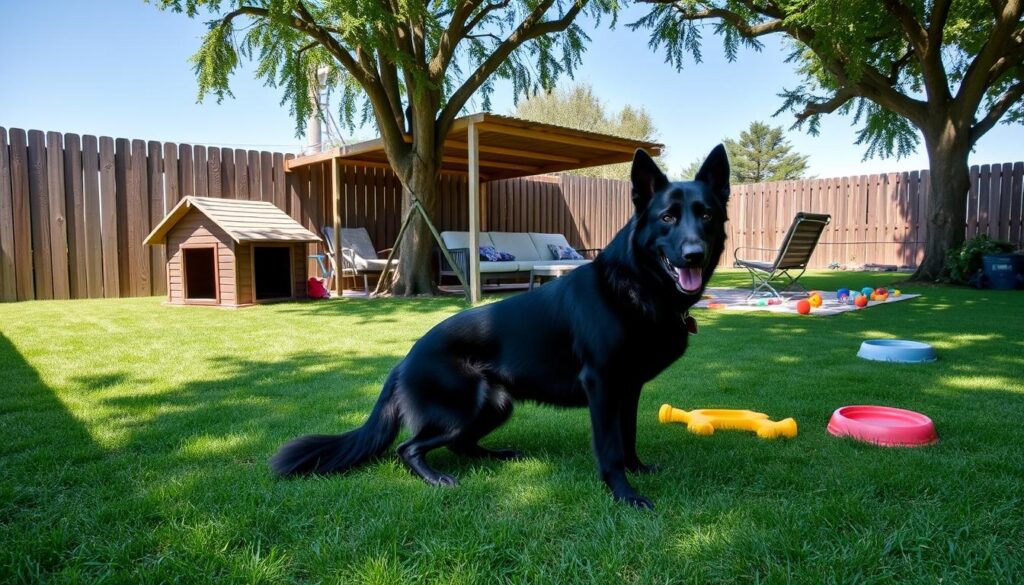How to Care for a White German Shepherd: Grooming, Diet, and More
Being a White German Shepherd owner is a special experience. These dogs are not just pets; they are loyal friends. They have a beautiful appearance and a great temperament. This guide will help you care for your White German Shepherd, so they can live their best life.

- Understanding the White German Shepherd Breed
- Essential Grooming Tips for Your White German Shepherd
- Nutrition Requirements and Dietary Guidelines
- Exercise and Physical Activity Needs
- Training Your White German Shepherd
- Common Health Issues and Prevention
- Socialization and Behavior Management
- Creating the Perfect Living Environment
- Comparing White German Shepherds to Other Coat Colors
- Conclusion
- FAQ
- What is the life expectancy of a White German Shepherd?
- How do I groom a long-haired White German Shepherd?
- Are White German Shepherds prone to any health issues?
- How much exercise does a White German Shepherd need?
- Can a White German Shepherd be a good family pet?
- How do White German Shepherds compare to other coat colors?
Understanding the White German Shepherd Breed
The white German shepherd is a unique and striking variant of the iconic German shepherd dog. They have pristine white coats that make them stand out. These dogs are not just beautiful; they have a gentle demeanor too. Let’s explore the fascinating world of this remarkable breed.
Physical Characteristics and Temperament
White German shepherds have a similar build to standard-colored ones. They are well-muscled and athletic. Their coats are stunning white, ranging from ivory to pure snow-white. These dogs are loyal, intelligent, and versatile, making them great companions and working dogs.
Common Health Concerns
White German shepherds may face certain health issues. These include hip and elbow dysplasia, degenerative myelopathy, and allergies. Regular vet visits and proactive care are key to keeping them healthy.
Life Expectancy and Development Stages
White German shepherds live between 9 to 13 years on average. They go through many stages, from playful puppies to mature adults. Knowing these stages helps owners care for them properly.
Understanding the white German shepherd’s unique traits and needs is crucial. With proper care, these dogs will bring loyalty, intelligence, and charm into your life.
“The white German Shepherd embodies elegance and grace, with a spirit as pristine as its coat.”
Essential Grooming Tips for Your White German Shepherd
Keeping a long-haired German shepherd’s white coat clean needs careful grooming. Follow these tips to keep your dog’s fur in great shape and avoid health problems.
Brushing and Coat Maintenance
Brushing your long-haired German shepherd regularly is key. Brush their coat 3-4 times a week with a slicker brush or deshedding tool. This removes loose hair, spreads natural oils, and stops mats and tangles. Be gentle, as their long fur can easily get tangled.
Bathing Schedule and Products
White German shepherds need a bath every 4-6 weeks to look their best. Use a mild, sulfate-free dog shampoo to keep their skin healthy. Avoid over-bathing, as it can strip natural oils and dry out their coat. End with a moisturizing conditioner for softness and shine.
Nail Care and Dental Hygiene
Don’t forget about nail care and dental hygiene for your long-haired German shepherd. Trim their nails every 4-6 weeks to avoid pain and injuries. Brush their teeth a few times a week with a soft toothbrush and dog-safe toothpaste for good oral health.
By sticking to these grooming tips, your long-haired German shepherd will stay happy and healthy. Regular care and attention to their grooming needs will keep them looking and feeling their best.
Nutrition Requirements and Dietary Guidelines
Keeping your German shepherd mix healthy starts with a good diet. These dogs need certain nutrients to stay active and well. Knowing what to feed them, how much, and when helps keep them at a healthy weight.
German shepherd mixes need a mix of proteins, fats, carbs, vitamins, and minerals. Choose dog food made for active, large breeds. Or, talk to your vet about a custom diet plan. Adjust the food amounts based on your dog’s age, how active they are, and their body shape.
- Protein sources: Look for protein-rich foods like lean meats, fish, and eggs to support muscle development and maintenance.
- Healthy fats: Include sources of omega-3 and omega-6 fatty acids, such as fish oil or flaxseed, to promote a healthy coat and skin.
- Carbohydrates: Choose complex carbohydrates like whole grains or sweet potatoes to provide sustained energy.
- Vitamins and minerals: Ensure your dog’s diet includes essential vitamins and minerals, such as calcium, phosphorus, and vitamins A and C, for overall health and development.
Feeding your German shepherd mix regularly and in the right amounts is key. They usually need two to three meals a day. Adjust this based on their needs and how much they move. Always ensure they have access to fresh, clean water.
By knowing what your German shepherd mix needs and feeding them right, you can keep them healthy and full of energy. This is important for their whole life.
Exercise and Physical Activity Needs
As a sable German shepherd owner, it’s key to know how important exercise is for your dog. These smart and lively dogs need a mix of physical and mental activities to stay healthy.
Daily Exercise Routines
Sable German Shepherds enjoy engaging in a variety of activities each day. A good routine includes:
- Long walks or jogs for at least 30-60 minutes
- Playtime in a secure, fenced-in area to allow for running and exploring
- Participating in mentally stimulating games like fetch or hide-and-seek helps keep them active and sharp.
Mental Stimulation Activities
Sable German shepherds also need mental challenges to avoid boredom and bad habits. Add these activities to their daily routine:
- Obedience training sessions, reinforcing basic commands
- Puzzle toys or snuffle mats to encourage foraging and problem-solving
- Nose work exercises, where your dog uses its keen sense of smell to locate hidden treats
Exercise Duration by Age
The amount of exercise a sable German shepherd needs changes with age. Here are some guidelines:
| Age | Exercise Duration |
|---|---|
| Puppy (under 1 year) | Short, frequent sessions of 5-15 minutes |
| Young Adult (1-3 years) | 30-60 minutes per day |
| Mature Adult (4-7 years) | 60-90 minutes per day |
| Senior (8+ years) | Reduced duration, with more frequent breaks |
By mixing physical and mental activities, you can make sure your sable German shepherd is happy and healthy.
Training Your White German Shepherd
Having a White German Shepherd means you need to train them in a special way. These dogs are smart, active, and love structure and positive feedback. By using the right training methods, your White German Shepherd will grow into a well-behaved and loyal friend.
Positive Reinforcement Training
Positive reinforcement is the best way to train a White German Shepherd. This method rewards good behavior, making your dog want to do it again. Use treats, praise, and toys to keep your pup excited about learning. Never use harsh punishment, as it can hurt your bond.
Obedience Training
Obedience training is key for White German Shepherds. It shows them who’s in charge and teaches them basic commands. Start with simple commands like “sit,” “stay,” and “come.” Then, move on to harder skills. Remember, be patient and consistent.
Socialization Strategies
Socialization is vital for White German Shepherds. It makes them friendly, confident, and well-adjusted. Expose your dog to a variety of people, animals, and environments from an early age. Keep up with socialization as they grow, to avoid bad behavior and ensure they’re comfortable everywhere.
| Training Technique | Benefits | Best Practices |
|---|---|---|
| Positive Reinforcement | Builds trust, encourages desired behaviors | Use treats, praise, and toys to reward good behavior |
| Obedience Training | Establishes leadership, teaches basic commands | Start with foundational commands, be consistent and patient |
| Socialization | Prevents behavioral issues, builds confidence | Introduce your pup to new people, animals, and environments from an early age |
By using these training methods, your White German Shepherd will become a well-behaved and loyal friend. With patience, consistency, and a positive attitude, you can help your dog reach their full potential. Enjoy a rewarding relationship with your dog.
Common Health Issues and Prevention
As a proud owner of a white German shepherd, knowing about common health issues is key. German shepherds are generally healthy, but some genetic problems can affect them. It’s important to take steps to keep your dog healthy and happy for a long time.
Genetic Health Concerns
White German shepherds often face hip and elbow dysplasia. This can cause joint pain and make it hard for them to move. Regular vet visits and screenings are vital to catch these problems early and treat them.
Preventive Care Measures
- Feed your dog a balanced diet to keep them healthy.
- Make sure they get enough exercise and mental challenges to stay fit.
- Keep them up to date on vaccinations and preventatives to fight off diseases.
- Practice good grooming to keep their coat and body clean.
Regular Health Check-ups
It’s crucial to take your white German shepherd for vet check-ups at least once a year. These visits help your vet keep an eye on your dog’s health. They can spot problems early and help your dog live a long, healthy life.

“Regular veterinary check-ups are essential for ensuring the health and longevity of your white German Shepherd.”
Socialization and Behavior Management
Raising a well-behaved German shepherd mix starts with socialization and behavior management. These steps help your pet feel comfortable in different places. They also learn to interact well with people, animals, and their surroundings.
Socialization is key for your German shepherd mix. Start by introducing them to new things slowly. This lets them learn and explore safely. Positive experiences with various sights, sounds, and people boost their confidence and adaptability.
- Enroll your German shepherd mix in socialization classes for structured interactions.
- Take them to parks, pet-friendly stores, and different neighborhoods to get used to new places.
- Give lots of praise and rewards for calm, friendly behavior during socialization.
Managing your German shepherd mix‘s behavior is also vital. Set clear rules and train consistently to stop bad behaviors like jumping or barking. Use positive reinforcement and patience to shape their behavior.
- Sign up for obedience training to teach important commands and strengthen your bond.
- Follow a daily routine to keep them mentally stimulated and prevent bad behavior.
- Seek help from a professional trainer or behaviorist for ongoing behavioral issues.
Focus on socialization and behavior management to raise a well-adjusted German shepherd mix. With patience, consistency, and positive reinforcement, your pet will thrive in any setting.
Creating the Perfect Living Environment
It’s crucial to make sure your all black German shepherd has a comfy and safe place to live. Designing both indoor and outdoor spaces well helps create a perfect environment for them. This environment should meet all their needs.
Indoor Space Requirements
For your all black German shepherd’s indoor space, think about enough room to move, cozy spots to rest, and a place for food and water. Aim for at least 200 square feet of open space. Also, make sure there’s room for their crate, toys, and other important things.
- Give them a comfy and durable dog bed or cushion for resting.
- Choose high-quality, chew-resistant toys to keep them mentally active.
- Make sure they have easy access to fresh water and a spot for eating.
Outdoor Setup and Safety
Adding the outdoors to your all black German shepherd’s living area can really improve their life. When setting up the outdoor space, focus on making it safe, fun, and comfy for them.
- Put up a strong, escape-proof fence or enclosure to keep them safe.
- Make sure they have shaded spots, like a dog house or covered patio, to stay cool.
- Add interactive things like a sandbox, digging pit, or small pool to keep them active and engaged.
By focusing on your all black German shepherd’s indoor and outdoor needs, you can make a space that’s just right for them. This space will help keep them healthy and happy.

| Indoor Space Requirements | Outdoor Setup and Safety |
|---|---|
| Minimum 200 square feet of open floor space | Sturdy, escape-proof fencing or enclosure |
| Comfortable dog bed or cushion | Shaded areas for protection from elements |
| Chew-resistant toys for mental stimulation | Interactive features like sandbox, digging pit, or pool |
| Designated feeding and water station | Secure and safe outdoor environment |
Comparing White German Shepherds to Other Coat Colors
German shepherd dogs come in many coat colors. The sable German shepherd is well-known, but the white German shepherd is unique and eye-catching. It’s important to know the differences and similarities between these dogs.
The coat color affects a dog’s temperament and health. White German shepherds are often calmer and more even-tempered than sable ones. Also, some health issues are more common in certain coat colors. So, it’s key to research the breed’s health before choosing.
| Coat Color | Temperament | Health Considerations |
|---|---|---|
| White German Shepherd | Calmer and more even-tempered | Potential for increased risk of certain genetic conditions |
| Sable German Shepherd | May have a more assertive and energetic personality | Reduced risk of some genetic health issues compared to white coat |
Both white German shepherds and sable ones need regular grooming. But, the white coat shows dirt more easily. So, it needs more baths and grooming to look good.
Choosing between a white or sable German shepherd depends on your preferences and lifestyle. Knowing about coat colors helps you make a good choice. This way, you can give your dog the best care.
Conclusion
Caring for a white German shepherd needs a full plan. This includes grooming, nutrition, exercise, and health checks. Knowing the breed’s special traits and common problems helps you give your dog the best care.
Keeping their coat clean and skin healthy is key. A balanced diet and enough exercise are also vital. Watching out for health issues and acting fast is important for their happiness and health.
With the tips from this article, you’re ready to care for your white German shepherd. You’ll build a strong bond and ensure your dog’s life is filled with joy and health.
FAQ
What is the life expectancy of a White German Shepherd?
White German Shepherds live between 9 to 13 years. This is similar to other German Shepherd colors. With proper care, nutrition, and vet visits, they can live a long, healthy life.
How do I groom a long-haired White German Shepherd?
Brush your long-haired White German Shepherd daily to avoid matting. Bathe them every 4-6 weeks with a gentle shampoo. Don’t forget to trim their nails and brush their teeth for dental health.
Are White German Shepherds prone to any health issues?
Yes, White German Shepherds might face health problems like hip and elbow dysplasia. They could also have degenerative myelopathy and von Willebrand’s disease. Regular vet visits and early detection are key to managing these issues.
How much exercise does a White German Shepherd need?
White German Shepherds need lots of exercise. Aim for at least 60 minutes of activity like walks, jogging, or playtime. They also need mental stimulation through training and toys.
Can a White German Shepherd be a good family pet?
Yes, White German Shepherds are great family pets. They are loyal, intelligent, and gentle. They get along well with children. Just remember to socialize and train them well.
How do White German Shepherds compare to other coat colors?
White German Shepherds are similar to other colors in many ways. But, they might have different temperaments, health issues, and care needs. It’s crucial to learn about the specific needs of White German Shepherds to care for them best.



